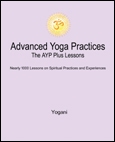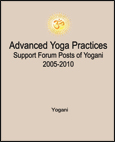|
Public Home | Plus Home | Main Lessons | Tantra Lessons | Public Forum | Plus Forum | Downloads | Books Topic Paths | Search | Training-Retreats | Testimonials | Survey | Interviews | MultiMedia | Contact | Donate |
|
Advanced Yoga Practices Note: For the Original Internet Lessons with additions, see the AYP Easy Lessons Books. For the Expanded and Interactive Internet Lessons, AYP Online Books, Audiobooks and more, see AYP Plus. Lesson 129 - Nauli - Raising Kundalini with Your Abdominal Muscles (Audio)
AYP Plus Additions:
From: Yogani New Visitors: It is recommended you read from the beginning of the web archive, as previous lessons are prerequisite to this one. The first lesson is, "Why This Discussion?"
In yoga (not baseball!), once we are in this "shortstop" position, we expel all the air from our lungs, and then lift our diaphragm. If we do this with a bare midriff, we will see our abdomen go in as the diaphragm is going up into the chest cavity. Most schools of yoga teach this standing uddiyana as part of a regular routine of postures, and this is a good time to practice it, during asanas before our pranayama and meditation. Uddiyana has good health benefits. It also draws energy up from our pelvic region, which is why it is part of yoni mudra kumbhaka, along with the other mudras and bandhas we do, all aimed at awakening and moving kundalini energy upward through the nervous system. With uddiyana we use the abdomen in a fairly static way, not doing anything dynamic with the abdominal muscles. We just pull the abdomen in by lifting the diaphragm up. We can make uddiyana dynamic by going up and down with the diaphragm. We'd like to jazz things up even more, and put more stimulation on the kundalini energy in our pelvic region. By doing so, we will also be setting the stage for an integrated network of whole-body micro-movements that occur as ecstatic conductivity rises and matures in our nervous system. Part of this integration will be an automatic linkup between the movements in the abdomen and the movements in the pelvic region, eventually giving us ecstatic micro-movements from the root all the way up into the chest. Of course, none of this starts out as "micro-movements." We have to begin with "macro-movements," which is what the mudras and bandhas are when we first learn them. If we are learning to play the violin, we have to master the long simple monotone strokes before we can indulge in the short complex multitone ones. Like that, the mudras and bandhas usually begin as pronounced and visible, and then naturally refine over time to be subtle invisible automatic manipulations deep within our increasingly ecstatic nervous system. Then, it is the movement of ecstatic kundalini energy in our nervous system that performs the micro-movements all over our body, and we become a witness to an unending glorious display of luminous neuro-biology going on inside us. The dynamic technique that takes us beyond uddiyana is called "nauli," which means, "to churn," or "to twirl." We begin in the standing "shortstop" position described above. Then we do uddiyana, expelling all our air, and pull our diaphragm up, which pulls our abdomen in. So there we are in uddiyana. Now we will do some other things to develop nauli. Let's take it step-by-step. Once in uddiyana, the first thing we do is contract our abdominal muscles by pressing down on our knees equally through both our arms. It is like doing a sit-up while we are standing up. Only no sit-up movement happens because our arms and hands are bracing our upper body on our knees. We are in uddiyana while we are doing this, so our abdomen is still pulled in by our raised diaphragm. Now something new is happening. Even though we are pulling our abdomen in with our diaphragm, we will notice our abdominal muscles bulging out in a line, up and down the center of our belly. This adds a great deal more suction on the pelvic region. Try flexing your abdominal muscles a few times while in uddiyana and see how they appear along the center line of your belly. Summary: Stand like a shortstop, hands on knees. Expel all your air. Lift your diaphragm. Notice your abdomen being pulled in. Then pull your upper body (braced with hands on your knees) down toward your knees with your abdominal muscles in a sit-up fashion. See the line of abdominal muscles bulging in a line down the center of your belly. See how easy it is? Feel the extra suction pulling up on your pelvic region? Great! Now you've got it. Now flex those abdominal muscles a few times. Get a rhythm going, doing a flex every few seconds. Find a rhythm that feels good for you. As you do this a few more times, you may find that flexing the abdominal muscle fits with whatever level of mulabandha/asvini you have become familiar with. Let them go together if you want. In time, they will become integrated together on a subtle neurological level and you will not be able to do one without being inclined to do the other. That kind of natural integration will happen with all the mudras and bandhas in the body. But more on that later. So here you are, flexing away. Maybe you are feeling some nice energy coming up into your belly, and maybe beyond into your chest, and even all the way up into your head. The abdominals are very powerful for raising kundalini like that. But, you know, this is not nauli yet. We haven't started "twirling" those muscles yet. The key to twirling is separating the flexing of our left abdominal muscle from the flexing of our right one, and then coordinating the two flexings into a twirling motion. We have two long abdominal muscles in there. One goes up and down the right side of our belly, and the other one goes up and down the left side. How do we separate them? It isn't very difficult to learn how, thanks to our shortstop position. So, set up in the shortstop position for uddiyana and nauli, just as before. This time, instead of contracting down with the abdominals with equal pressure through both arms on to both knees, just contract down through one arm on to one knee. Take your pick on which one. Once in uddiyana, just contract with your abdomen down on to one knee through one arm. What happens? Did you see one side of your abdominal muscles flex out, and the other side stay in? If so, you've got it right. Now switch to the other side. Flex your abdomen with all the pressure going to the other knee through the other arm. Did the other side of your abdominal muscles flex out? Good. Now try going back and forth, with the same rhythm you used when you were doing both sides at the same time. Only this time, it will be left side, right side, left side, right side, and so on. Now you are drawing up on the pelvic region on alternating sides. This will be more stimulating on the kundalini energy. Are you ready to go for the whole thing? Let's see if we can twirl those muscles. Assuming you have the abdominal muscles going smoothly back and forth from left to right, there is just one more step to have full nauli going. Instead of going in and out with the muscles from left to right one at a time, try doing a "sweep" across from left to right. This means that while your left abdominal is flexed out, you come up with the right one before the left one is releasing, so both are flexed in the middle for an instant. Then as you go more to the right side flex, the left will release. The effect is that you see one continuous movement of your abdominal muscles going across your belly from left to right - a sweep. Then as your right muscle releases going back in, the left one is coming back up. Then across you go again from left side flexed to right side flexed. And around and around you go, twirling left to right, left to right, again and again. You can sense and regulate the twirling by feeling the shift in pressure going through your arms from left knee to right knee as the flexing of your abdominal muscles shifts from the left side to the right side, and then back. It is training to develop a habit we are doing in this early stage of nauli. It will be "clunky" in the beginning, no doubt. But don't give up. You will get the hang of it. First learn it going one way. We started twirling the muscles out from left to right. Once you have that going well, then get it going the other way, from right to left. Once you are able to twirl either way, you will be on your way to being a nauli expert. With some practice you will be able to twirl your abdominal muscles like a jump rope, with delicious effects on the energy in your pelvic region. Kundalini will not be able resist coming up with all that stimulation caressing her. We don't do this macro-movement nauli during our sitting practices. We do it before we sit to do pranayama and meditation. It can be part of our asanas, included when we do uddiyana in our routine. Or, if we are not in the habit of doing asanas, we can do nauli by itself before we sit for practices. Doing nauli before our sitting practices awakens our nervous system in ways that are very supportive of pranayama, yoni mudra kumbhaka, and meditation. Try and do at least twenty rotations of nauli in each direction before every session of pranayama and meditation. If you are running out of breath while doing nauli, don't strain. Just pause, take a deep breath or two, exhale again, and continue. As you become familiar with nauli, you will also be able to do it less formally in situations that do not involve the shortstop position. For example, once you have the habit of separate control of the two abdominal muscles, it will become easy to do while lying on your back relaxing, and, eventually, while sitting up. In time, nauli will refine to the point where you will be able to do it subtly with no visible motion just about anywhere, with wonderful ecstatic effects. This kind of nauli goes very nicely with subtle movements of mulabandha/asvini, while in kechari. These ecstatic exercises can be done in public without anyone knowing you are doing them, except for the glow, of course. We will be using a subtle version of nauli when we move on to dynamic jalandhara (the "chin pump"), which involves the upper body to a much greater extent in the stimulation of kundalini energy between the heart to the head. Nauli is a powerful practice with far reaching effects. We did not include the normal precautions at the beginning of this lesson because nauli is not usually a practice that can throw us immediately into trouble with kundalini energy. It goes without saying that if you have any health problems that could be aggravated by nauli, then you should refrain from doing it. Also, if nauli is practiced over a period of time without the benefit of the global purification practices of meditation and spinal breathing, it could lead to energy imbalances in the body. It is beneficial to have good overall purification practices established before taking on any practices that target particular areas of the body for kundalini stimulation. This is why we started in the beginning of the lessons with meditation and spinal breathing, and continue to call them the core advanced yoga practices -- the prerequisites for everything else we undertake. If you want, you can do nauli before learning other advanced yoga practices beyond meditation and spinal breathing. Those two would be the recommended minimum prerequisites for nauli. Always make sure you are smooth with your practices before taking on new ones. It is very important to maintain a stable platform of practices that you can sustain over the long run. When you know you are ready, you can methodically add on new practices as your bhakti calls you to more. The guru is in you.
Discuss this Lesson in the AYP Plus Support Forum Note: For instructions on nauli, see the Asanas, Mudras and Bandas book and the AYP Diet, Shatkarmas and Amaroli book, and AYP Plus.
|
|
|
|
Join the Mail List:
AYP Retreats
eBooks - PDF, EPUB
FREE eBooks with
SAVE with Bundled
|

























